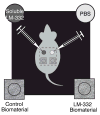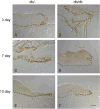Topical application of laminin-332 to diabetic mouse wounds
- PMID: 17719208
- PMCID: PMC2151474
- DOI: 10.1016/j.jdermsci.2007.07.002
Topical application of laminin-332 to diabetic mouse wounds
Abstract
Background: Keratinocyte migration is essential for wound healing and diabetic wound keratinocytes migrate poorly. Keratinocyte migration and anchorage appears to be mediated by laminin-332 (LM-332). Impaired diabetic wound healing may be due to defective LM-332 mediated keratinocyte migration.
Objective: To evaluate LM-332 expression in diabetic (db/db) and control (db/-) mice and to test LM-332 wound healing effects when applied to mouse wounds.
Methods: LM-332 expression in mouse wounds was evaluated using immunohistochemistry. LM-332 wound healing effects were evaluated by directly applying soluble LM-332, a LM-332 biomaterial, or a control to mouse wounds. Percent wound closure and histology score, based on healing extent, were measured.
Results: Precursor LM-332 expression was markedly reduced in db/db when compared to db/- mice. In vitro, soluble LM-332 and LM-332 biomaterial demonstrated significant keratinocyte adhesion. In vivo, soluble LM-332 treated wounds had the highest histology score, but significant differences were not found between wound treatments (p>0.05). No differences in percentage wound closure between treatment and control wounds were found (p>0.05).
Conclusion: The db/db wounds express less precursor LM-332 when compared to db/-. However, LM-332 application did not improve db/db wound healing. LM-332 purified from keratinocytes was primarily physiologically cleaved LM-332 and may not regulate keratinocyte migration. Application of precursor LM-332 rather than cleaved LM-332 may be necessary to improve wound healing, but this isoform is not currently available in quantities sufficient for testing.
Figures








Similar articles
-
14S,21R-dihydroxydocosahexaenoic acid remedies impaired healing and mesenchymal stem cell functions in diabetic wounds.J Biol Chem. 2011 Feb 11;286(6):4443-53. doi: 10.1074/jbc.M110.100388. Epub 2010 Nov 26. J Biol Chem. 2011. PMID: 21112969 Free PMC article.
-
HoxD3 accelerates wound healing in diabetic mice.Am J Pathol. 2003 Dec;163(6):2421-31. doi: 10.1016/S0002-9440(10)63597-3. Am J Pathol. 2003. PMID: 14633614 Free PMC article.
-
Improvement of skin wound healing in diabetic mice by kinin B2 receptor blockade.Clin Sci (Lond). 2016 Jan;130(1):45-56. doi: 10.1042/CS20150295. Epub 2015 Oct 6. Clin Sci (Lond). 2016. PMID: 26443866
-
Understanding the multifaceted mechanisms of diabetic wound healing and therapeutic application of stem cells conditioned medium in the healing process.J Tissue Eng Regen Med. 2019 Dec;13(12):2218-2233. doi: 10.1002/term.2966. Epub 2019 Nov 19. J Tissue Eng Regen Med. 2019. PMID: 31648415 Review.
-
Topical metformin in wound healing: a comprehensive systematic review of therapeutic outcomes.Arch Dermatol Res. 2025 May 16;317(1):760. doi: 10.1007/s00403-025-04277-w. Arch Dermatol Res. 2025. PMID: 40377758 Review.
Cited by
-
MicroRNA-146a Deficiency Delays Wound Healing in Normal and Diabetic Mice.Adv Wound Care (New Rochelle). 2022 Jan;11(1):19-27. doi: 10.1089/wound.2020.1165. Epub 2021 Jul 2. Adv Wound Care (New Rochelle). 2022. PMID: 33554730 Free PMC article.
-
Activation of poly(ADP-ribose) polymerase-1 delays wound healing by regulating keratinocyte migration and production of inflammatory mediators.Mol Med. 2014 Aug 26;20(1):363-71. doi: 10.2119/molmed.2014.00130. Mol Med. 2014. PMID: 25014793 Free PMC article.
-
Angiogenic laminin-derived peptides stimulate wound healing.Int J Biochem Cell Biol. 2008;40(12):2771-80. doi: 10.1016/j.biocel.2008.05.025. Epub 2008 Jun 20. Int J Biochem Cell Biol. 2008. PMID: 18603014 Free PMC article.
-
Human adipose-derived stromal cells accelerate diabetic wound healing: impact of cell formulation and delivery.Tissue Eng Part A. 2010 May;16(5):1595-606. doi: 10.1089/ten.TEA.2009.0616. Tissue Eng Part A. 2010. PMID: 20038211 Free PMC article.
-
Dedicator of Cytokinesis 5 Regulates Keratinocyte Function and Promotes Diabetic Wound Healing.Diabetes. 2021 May;70(5):1170-1184. doi: 10.2337/db20-1008. Epub 2021 Feb 24. Diabetes. 2021. PMID: 33627322 Free PMC article.
References
-
- Pecoraro RE, Reiber GE, Burgess EM. Pathways to diabetic limb amputation. Basis for prevention. Diabetes Care. 1990;13(5):513–21. - PubMed
-
- Reiber GE. The epidemiology of diabetic foot problems. Diabet Med. 1996;13(Suppl 1):S6–11. - PubMed
-
- American Diabetes Association. Consensus Development Conference on Diabetic Foot Wound Care. Diabet Care. 1999;22(8):1354–60. - PubMed
-
- Sullivan S, Underwood R, Gibran N, Sigle RO, Usui M, Carter WG, O JE. Validation of a model for the study of multiple wounds in the diabetic mouse (db/db) Plast Reconstr Surg. 2004;113(3):953–960. - PubMed
-
- Tsuboi R, Shi CM, Rifkin DB, Ogawa H. A wound healing model using healing-impaired diabetic mice. J Dermatol. 1992;19(11):673–5. - PubMed
Publication types
MeSH terms
Substances
Grants and funding
LinkOut - more resources
Full Text Sources
Medical
Miscellaneous

